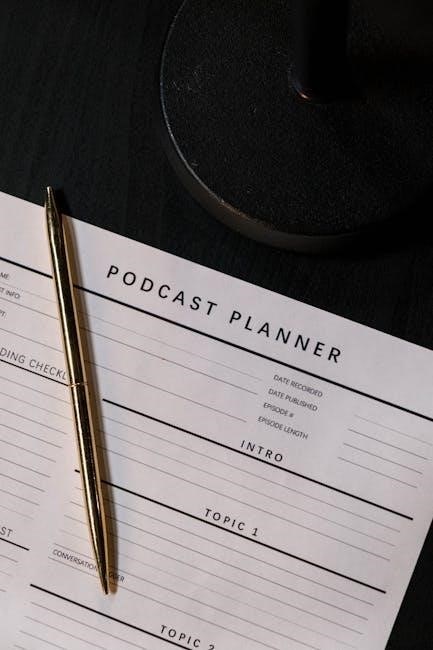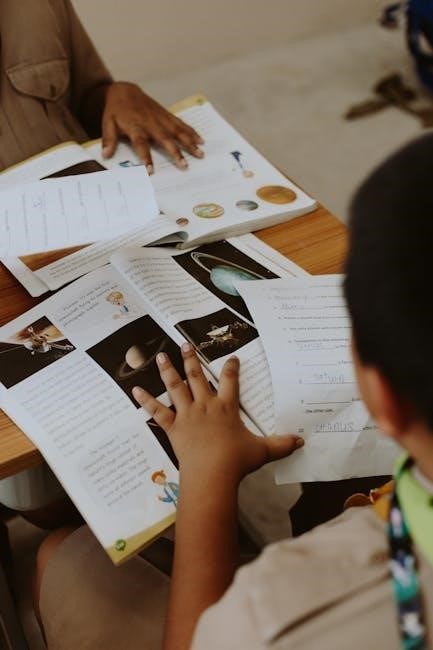
lcm and gcf worksheet pdf
LCM and GCF worksheets provide a comprehensive approach to understanding these essential math concepts through interactive problems and real-world applications, enhancing critical thinking and problem-solving abilities, ideal for students seeking to master foundational math skills.
What are LCM and GCF?
The Least Common Multiple (LCM) is the smallest number that is a multiple of two or more numbers, while the Greatest Common Factor (GCF), also known as the Greatest Common Divisor (GCD), is the largest number that divides two or more numbers without leaving a remainder. LCM is used to find a common multiple shared by multiple numbers, often essential for solving problems involving rates, cycles, or synchronous events. GCF, on the other hand, is crucial for simplifying fractions, factoring numbers, and solving problems involving divisibility; Both concepts are foundational in mathematics, particularly in algebra, number theory, and solving real-world problems. Understanding LCM and GCF enhances problem-solving skills and provides a strong base for advanced mathematical concepts.

Why are LCM and GCF Important in Math?
LCM and GCF are fundamental concepts in mathematics that form the basis for various advanced topics. LCM is essential for solving problems involving multiples, such as scheduling events or calculating intervals, while GCF is crucial for simplifying fractions, factoring polynomials, and solving division problems. These concepts help in breaking down complex problems into manageable parts, improving problem-solving efficiency. Proficiency in LCM and GCF enhances understanding of number relationships, which is vital for algebra, geometry, and real-world applications like finance and engineering. Regular practice with LCM and GCF worksheets ensures a strong foundation in mathematical reasoning and prepares students for higher-level mathematics. Additionally, these skills are often required in standardized tests and academic assessments, making them indispensable for academic success.

Finding the Greatest Common Factor (GCF)
Finding the GCF involves identifying the largest number that divides two or more numbers without leaving a remainder, a key skill for simplifying fractions and solving division problems effectively.
Methods to Find GCF

There are multiple effective methods to determine the Greatest Common Factor (GCF) of two or more numbers. The prime factorization method involves breaking down each number into its prime factors and identifying the common ones. Listing factors is another approach, where you list all factors of each number and find the largest one they share. Additionally, the division method involves dividing the larger number by the smaller one and repeating the process with the remainder until it reaches zero. Each method ensures accuracy and efficiency in finding the GCF, a fundamental skill for simplifying fractions, solving division problems, and understanding number relationships. Practicing these methods through worksheets helps build confidence and mastery in mathematical problem-solving.
Prime Factorization for GCF
Prime factorization is a systematic method to find the Greatest Common Factor (GCF) of two or more numbers. By breaking down each number into its prime factors, you can identify the common factors and multiply them to determine the GCF. For example, to find the GCF of 12 and 18, list their prime factors: 12 = 2 × 2 × 3 and 18 = 2 × 3 × 3. The common prime factors are 2 and 3, so the GCF is 2 × 3 = 6. This method is reliable and reduces errors, making it ideal for understanding number relationships and simplifying fractions. Worksheets often include exercises that use prime factorization to help students master this essential math skill. Regular practice with these problems enhances problem-solving abilities and builds a strong foundation in mathematics.
Listing Factors to Determine GCF
Listing factors is a straightforward method to find the Greatest Common Factor (GCF) of two or more numbers. To do this, write down all the factors of each number and identify the highest common factor. For example, to find the GCF of 8, 36, and 46, list the factors of each:
– Factors of 8: 1, 2, 4, 8
– Factors of 36: 1, 2, 3, 4, 6, 9, 12, 18, 36
– Factors of 46: 1, 2, 23, 46
The common factors are 1 and 2, with 2 being the highest. Thus, the GCF is 2. This method is simple and effective, especially for smaller numbers, though it can be time-consuming for larger ones. Worksheets often include exercises like these to help students practice and master the concept of finding GCF through factor listing. Regular practice enhances understanding and improves math problem-solving skills.

Finding the Least Common Multiple (LCM)
Finding the LCM involves identifying the smallest number that is a multiple of two or more given numbers. This is essential for solving problems involving multiples and real-world applications.
Methods to Find LCM

There are several effective methods to find the Least Common Multiple (LCM) of numbers, including listing multiples, prime factorization, and using the division method. Listing multiples involves writing out the multiples of each number until a common multiple is found, which is practical for smaller numbers. Prime factorization is a more efficient approach, where you break down each number into its prime factors and then take the highest power of each prime to calculate the LCM. The division method involves dividing the numbers by their Greatest Common Factor (GCF) to determine the LCM. These methods are widely used in math worksheets and word problems to solve real-world scenarios, such as scheduling and resource allocation.
Using Multiples to Determine LCM
Using multiples is a straightforward method to determine the Least Common Multiple (LCM) of numbers. Start by listing the multiples of each number in ascending order. For example, to find the LCM of 4 and 6, list the multiples of 4 (4, 8, 12, 16, 20, …) and the multiples of 6 (6, 12, 18, 24, …). The smallest common multiple in both lists is 12, making it the LCM. This method is simple but can become time-consuming for larger numbers. Worksheets often include exercises where students identify the LCM by comparing multiples, helping them understand the concept visually. This approach is particularly useful for introducing the idea of LCM to beginners before moving on to more advanced methods like prime factorization.
Prime Factorization for LCM
Prime factorization is an efficient method to determine the Least Common Multiple (LCM) of numbers. To use this approach, break down each number into its prime factors. For example, to find the LCM of 12 and 18, factorize them into primes: 12 = 2² × 3¹ and 18 = 2¹ × 3². Next, take the highest power of each prime number present in the factorizations: 2² and 3². Multiply these together to get the LCM: 2² × 3² = 4 × 9 = 36. This method is particularly useful for larger numbers and provides a clear, systematic way to find the LCM. Worksheets often include exercises that utilize prime factorization, helping students refine their skills in identifying and calculating the LCM accurately. This approach also deepens the understanding of how prime factors contribute to the smallest common multiple.

Importance of LCM and GCF in Real-World Scenarios
LCM and GCF are essential in real-life situations, such as dividing items equally, scheduling events, and determining materials for construction, making them vital skills for practical problem-solving and efficient planning.
Applications of GCF in Word Problems
The Greatest Common Factor (GCF) is widely used in solving various word problems, such as dividing objects equally, simplifying fractions, and determining the largest possible size for groups or materials. For example, if Sara has 16 red flowers and 24 yellow flowers, she can use the GCF of 16 and 24, which is 8, to create bouquets with an equal number of each flower type. Similarly, in construction, GCF helps in measuring materials efficiently. These practical applications highlight the importance of mastering GCF to solve real-world problems effectively, making it a fundamental skill in mathematics; Worksheets and practice problems are essential for gaining proficiency in applying GCF to diverse scenarios, ensuring students can tackle such challenges with confidence and accuracy.
Applications of LCM in Word Problems
The Least Common Multiple (LCM) is crucial for solving problems involving repeating events, such as scheduling, periodic tasks, and combining groups. For instance, if pencils are sold in packages of 10 and erasers in packages of 12, Phillip can determine the LCM of 10 and 12, which is 60, to find when both items will be available in whole packages simultaneously. Similarly, in manufacturing, LCM helps synchronize production cycles. These real-world applications demonstrate how LCM simplifies planning and coordination. Worksheets with LCM word problems are valuable tools for students to practice and understand these concepts, ensuring they can apply mathematical reasoning to everyday situations effectively. Regular practice with such problems enhances problem-solving skills and prepares students for more complex mathematical challenges.

LCM and GCF Word Problems
LCM and GCF word problems help students master these concepts through practical examples like combining packages or events, enhancing critical thinking and problem-solving in everyday real-world situations.
Solving GCF Word Problems
Solving GCF word problems involves identifying the greatest common factor of two or more numbers to address real-world scenarios. For example, Sara has 16 red flowers and 24 yellow flowers and wants to make bouquets with the same number of each. The GCF of 16 and 24 is 8, so she can make 8 bouquets with 2 red and 3 yellow flowers each. Similarly, Phillip buying pencils in packages of 10 and erasers in packages of 12 can determine the GCF of 10 and 12, which is 2, to find a common purchasing quantity. These problems require understanding how to apply GCF to practical situations, such as dividing items evenly or scheduling events. Worksheets often include these types of problems, providing students with hands-on practice. By mastering GCF word problems, students enhance their critical thinking and problem-solving skills.
Solving LCM Word Problems
Solving LCM word problems involves determining the least common multiple of two or more numbers to address real-world scenarios. For instance, if pencils are sold in packages of 10 and erasers in packages of 12, the LCM of 10 and 12 is 60, meaning Phillip will need to buy 6 packages of pencils and 5 packages of erasers to have equal quantities. Similarly, if a teacher wants to schedule two activities every 15 and 20 minutes, the LCM of 15 and 20 is 60, so both activities will align every hour. Worksheets provide various such problems, allowing students to apply LCM to practical situations like event planning, resource distribution, and more. By practicing these problems, students develop the ability to solve complex scheduling and organizational tasks efficiently.

Practice Worksheets for LCM and GCF
Practice worksheets for LCM and GCF offer a variety of problems, such as finding the GCF of 8, 36, 46 or the LCM of 15, 20, and 25, to enhance problem-solving skills and understanding of these concepts.

Worksheet Examples for GCF
Worksheets for GCF provide a variety of problems to help students master the concept. For example, one problem asks to find the GCF of 8, 36, and 46, while another involves determining the GCF of 30, 20, and 50. These exercises often include multiple-choice options or open-response formats to accommodate different learning styles. Word problems, such as Sara having 16 red flowers and 24 yellow flowers and wanting to make bouquets with equal numbers of each, challenge students to apply GCF in real-world scenarios. Additional practice includes finding the GCF of 15, 45, and 30, or 32 and 48. These worksheets are designed to reinforce understanding and build confidence in identifying common factors, making them essential for math skills development.
Worksheet Examples for LCM
LCM worksheets offer diverse exercises to help students grasp the concept of least common multiples. Problems include finding the LCM of pairs or sets of numbers, such as 3 and 4, 8 and 9, or 12 and 9. Advanced questions involve three numbers, like 8, 9, and 24. Worksheets often incorporate word problems, such as Phillip buying pencils in packages of 10 and erasers in packages of 12, asking for the LCM to determine when he will have equal numbers of both. Some exercises focus on prime factorization to find LCM, such as for 60 (2, 3, 5) and 84 (2, 3, 7). These worksheets cater to different learning styles with multiple-choice or open-response formats, ensuring students can practice and master LCM calculations effectively, preparing them for more complex mathematical challenges. Regular practice with these worksheets enhances problem-solving skills and mathematical fluency.
Mastering LCM and GCF through worksheets enhances problem-solving skills, reinforces mathematical concepts, and builds a strong foundation for advanced math, proving invaluable for academic and real-world applications.
LCM and GCF worksheets focus on understanding and applying essential math concepts. The greatest common factor (GCF) identifies the largest number dividing given numbers without a remainder, while the least common multiple (LCM) finds the smallest number that is a multiple of all provided numbers. These concepts are fundamental for solving word problems, simplifying fractions, and understanding multiples and factors. Worksheets often include prime factorization, listing multiples, and real-world applications to reinforce learning. Regular practice with these exercises improves problem-solving skills, mathematical accuracy, and logical reasoning. By mastering GCF and LCM, students build a strong foundation for advanced math topics like algebra and number theory, ensuring long-term academic success and practical application in everyday scenarios.
Benefits of Practicing with Worksheets
Practicing with LCM and GCF worksheets offers numerous benefits for students; These resources provide structured exercises that reinforce understanding of key concepts, helping students grasp how to find GCF and LCM through methods like prime factorization and listing multiples. Worksheets also improve problem-solving skills by exposing students to various numerical and word-based scenarios. Regular practice enhances computational accuracy, reduces errors, and builds confidence in tackling math challenges. Additionally, worksheets are an excellent tool for self-assessment, allowing students to track their progress and identify areas needing improvement. By consistently working through these exercises, students develop a strong foundation in number theory, which is crucial for success in algebra, geometry, and other advanced math subjects. This disciplined practice fosters a deeper appreciation for mathematics and its practical applications in daily life.